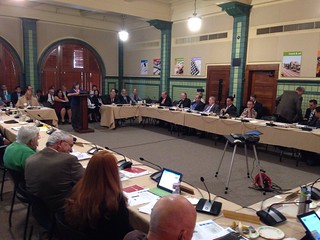 In March 2013, the American Diabetes Association released their most recent five-year update “The Economic Cost of Diabetes in the US in 2012,” which found that in 2012, diabetes cost the US a total of $245 billion, an increase of 41 percent from 2007.
In March 2013, the American Diabetes Association released their most recent five-year update “The Economic Cost of Diabetes in the US in 2012,” which found that in 2012, diabetes cost the US a total of $245 billion, an increase of 41 percent from 2007.
Resource Library
This report focuses on case studies describing how ten states (California, District of Columbia, Georgia, Illinois, Kentucky, Louisiana, New York, Oklahoma, Texas and Virginia) are awarding their SRTS federal funds to support improved infrastructure such as sidewalks, bike lanes, pathways, improved intersections, traffic calming, and more.
This research brief summarizes key results from a confidential online survey given to California school board members on “Physical Activity and Physical Education in California Schools” developed by the California School Boards Association (CSBA) and California Project LEAN (Leaders Encouraging Activity and Nutrition) (CPL).
 Just shy of one year since the passage of the new transportation law, MAP-21, the US Department of Transportation has issued the final guidance and a
Just shy of one year since the passage of the new transportation law, MAP-21, the US Department of Transportation has issued the final guidance and a
This report showcases how SRTS programs are resulting in the implementation of infrastructure improvements that close gaps in the non-motorized transportation network. Click here to read more about the four communities that were showcased – Avondale, AZ; Bozeman, MT; Knoxville, TN; and Miami, FL.
 Looking back, I never would have imagined that many of the recreational activities I participated in and enjoyed, especially walking and bicycling to school, climbing ropes in PE, hiking to the local nature center, and playing games at recess, would impact my life so significantly.
Looking back, I never would have imagined that many of the recreational activities I participated in and enjoyed, especially walking and bicycling to school, climbing ropes in PE, hiking to the local nature center, and playing games at recess, would impact my life so significantly.
This webinar from November 21, 2013 provides perspective on the importance of MAP-21 funding in underserved communities.
 In honor of July being Parks and Recreation month, I decided to focus on how we, as Safe Routes to School advocates, can ensure that all children have the ability to be active outside all year round. Just like walking and bicycling to school, access to parks and recreation can directly impact the overall quality of life for children.
In honor of July being Parks and Recreation month, I decided to focus on how we, as Safe Routes to School advocates, can ensure that all children have the ability to be active outside all year round. Just like walking and bicycling to school, access to parks and recreation can directly impact the overall quality of life for children.
 Last week, the US Department of Transportation (USDOT) released their draft strategic plan for FY2014-2018. This plan will drive the USDOT’s internal workplan, so it’s important to make sure Safe Routes to School, bicycling and walking is well-represented.
Last week, the US Department of Transportation (USDOT) released their draft strategic plan for FY2014-2018. This plan will drive the USDOT’s internal workplan, so it’s important to make sure Safe Routes to School, bicycling and walking is well-represented.
In December 2012, the U.S. Department of Health and Human Services (HHS) released The Physical Activity Guidelines for Americans Midcourse Report: Strategies to Increase Physical Activity Among Youth.
People who volunteer for a nonprofit or school may be concerned about a lawsuit if an injury occurs. This fact sheet provides an overview of legal protections designed to shield volunteers from liability.
 In early November 2013, the San Bernardino Association of Governments (SANBAG) board adopted a historic Memorandum of Understanding (MOU) (Item 7) with the Southern California Association of Governments (SCAG). The MOU commits the two agencies to working together on projects related to the implementation of the 2012 Regional Transportation Plan and Sustainable Communities Strategy (RTP/SCS). While the RTP/SCS is mandated by SB 375, state legislation to reduce greenhouse gas emissions through trying land use and transportation planning in the RTP process, the MOU is strictly voluntary.
In early November 2013, the San Bernardino Association of Governments (SANBAG) board adopted a historic Memorandum of Understanding (MOU) (Item 7) with the Southern California Association of Governments (SCAG). The MOU commits the two agencies to working together on projects related to the implementation of the 2012 Regional Transportation Plan and Sustainable Communities Strategy (RTP/SCS). While the RTP/SCS is mandated by SB 375, state legislation to reduce greenhouse gas emissions through trying land use and transportation planning in the RTP process, the MOU is strictly voluntary.
The MOU between SCAG and SANBAG demonstrates both agencies’ commitment to the policies, projects and strategies set forth in the 2012 RTP/SCS. It is important for County Transportation Commissions (CTCs) to show commitment to implementation of plans and policies.
Specific planning projects are included in SANBAG’s MOU that will transform San Bernardino County into a more walkable and bikeable place, improve the public health outcomes of its residents and help increase the number of children walking and bicycling to school. The MOU incorporates items recommended in the San Bernardino Active Transportation Vision, statistics and policy recommendations developed by stakeholders from San Bernardino County, including SANBAG staff, San Bernardino County Department of Public Health, Omnitrans, Safe Routes Partnership, American Lung Association, MoveIE and Inland Empire Bicycle Alliance.
The guide contains tactics for building or rebuilding cities and suburbs in ways that encourage walking.

Did you know that about 45 percent of Americans make New Year’s resolutions each year? As you can guess, favorite resolutions include losing weight, exercising more, and saving more money. Do you also know that ultimately only about 8 percent of resolutions are sustained?
This resource provides a compilation of tools developed for the Safe Routes Partnership's Local School Project and other projects to help in creating a user-friendly quantitative and qualitative framework, data collection tools, and a data collection plan. It includes a parent survey in English and Spanish.
 When I see children walking to or from school, I notice their interactions. They talk, laugh, and maybe drop their bags to engage in a spontaneous race. They move in pairs or small pods. There’s a special kind of connection as they transition to school or home. It’s an image which brings me hope.
When I see children walking to or from school, I notice their interactions. They talk, laugh, and maybe drop their bags to engage in a spontaneous race. They move in pairs or small pods. There’s a special kind of connection as they transition to school or home. It’s an image which brings me hope.
These briefings sheets were developed with funding support from the National Center for Safe Routes to School. The briefing sheets are intended for use by transportation engineers and planners to support their active participation in the development and implementation of Safe Routes to School programs and activities.
 All of us are working hard to make our neighborhoods safer for kids and families to walk to and from school. But now, we need your help to ensure that the health and safety of our loved ones does not take a back seat to automobile passengers, simply because they chose active transportation over driving.
All of us are working hard to make our neighborhoods safer for kids and families to walk to and from school. But now, we need your help to ensure that the health and safety of our loved ones does not take a back seat to automobile passengers, simply because they chose active transportation over driving.
In this monograph, the Prevention Institute has profiled eleven projects in predominantlylow-income communities where local residents mobilized public and private resources to makechanges in their physical environments to improve the health and quality of life for their citizens.


